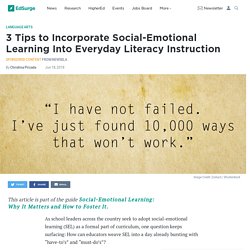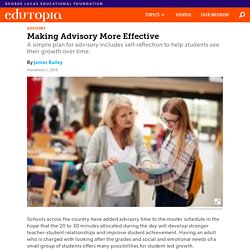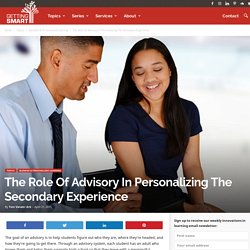

3 Tips to Incorporate Social-Emotional Learning Into Everyday Literacy Instruction. As school leaders across the country seek to adopt social-emotional learning (SEL) as a formal part of curriculum, one question keeps surfacing: How can educators weave SEL into a day already bursting with “have-to’s” and “must-do’s”?

Literacy instruction can serve as a model of how to do just that. Traditional approaches to literacy instruction are bolstered by cross-curricular methods; the same holds true for SEL instruction. Resilience, in particular, is a core SEL skill that translates well across subject areas. Whether students are reading literature about a character’s challenging journey, or learning to persevere through a difficult word problem, resilience is always relevant to a student’s—and teacher’s—journey. Moreover, pioneering work by Carol Dweck, Martin Seligman and Angela Duckworth has shown that the ability to cope and persevere through setbacks and adversity can indeed be taught and learned. 1. 2. 3.
Students today are a part of a unique generation. How to Make Social & Emotional Learning Authentic - PenPal Schools. Social & emotional learning is becoming a priority for many schools across America.

Increasingly, schools are spending budgets and class time on curriculum, software, and specialists to introduce SEL school-wide. A 2017 study by CASEL, the university of Illinois at Chicago, Loyola University, and the University of British Columbia show that students that regularly practice SEL show more positive behaviors and are more prepared for success in the workforce. Another 2011 study by CASEL found that social & emotional learning led to an 11 percentile point gain in academic performance. These studies also found that the benefits of social and emotional learning in school can impact students for up to 18 years!
While many schools now understand the value of SEL, many still struggle to provide students with opportunities to practice these skills authentically. When students do get opportunities to practice social emotional learning it’s usually with peers from the same school. Respect Empathy. The everlasting impact of SEL in schools. Six-Word Memoirs: The Video Story. High School Advisory Programs: Show Students They Matter. Making Advisory More Effective. Schools across the country have added advisory time to the master schedule in the hope that the 20 to 30 minutes allocated during the day will develop stronger teacher-student relationships and improve student achievement.

Having an adult who is charged with looking after the grades and social and emotional needs of a small group of students offers many possibilities for student-led growth. When I served as a superintendent, all of my secondary schools had a scheduled advisory time. Some schools used it for study hall, and others used it for announcements or character development. Occasionally, they would use the time to discuss grades or hand out report cards. I noticed that many teachers and students gave up on the potential of advisory time because they didn’t see the value, saw it as a waste of time, or didn’t have the tools to make it more effective. A Simple, Proactive, Student-Led System In our advisory design, every adult in the building had an advisory group that met daily. 2. The Role Of Advisory In Personalizing The Secondary Experience. The goal of an advisory is to help students figure out who they are, where they’re headed, and how they’re going to get there.

Through an advisory system, each student has an adult who knows them and helps them navigate high school so that they leave with a meaningful, personalized plan and are prepared for postsecondary options. An advisory is a key component of a distributed student guidance strategy that includes regular meetings between an advisor and a group of students, that meets at regular intervals, has a clear focus, and is something in which all students and staff participate in.
In the paper Core and More: Guiding and Personalizing College and Career Readiness, we asserted that the best student guidance systems are blended (leveraging technology and in-person instruction and services), distributed (leveraging staff in addition to school counselors), and scheduled (utilizing an advisory period).
This advisory period is really the glue that holds it all together. 5 Core Elements. Five Tips for Teaching Advisory Classes at Your School. Research shows that when students have a meaningful relationship with an adult at school, they are more likely to succeed academically—but traditional academic learning in high school often leaves little time to make these connections.

In the 1990s, schools started to take a greater interest in building more meaningful relationships between teachers and students—and one approach was the creation of what are known as “advisories,” advocated for in part by the Coalition of Essential Schools. In practice, advisory works in a myriad of ways at different schools. At some, it meets once a week for 30 minutes; at others, it is the heart of the school culture and meets nearly every day. Many traditional public schools still do not have advisory, but independent schools, charter schools, and more outside-the-traditional-box public schools do. CREEDproject. CREDO RESOURCES.